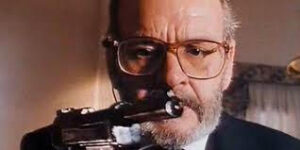Many people deserve to be called the “Godfather of Gore,” but Italian director Lucio Fulci has a stronger case than most. This is a director who, for some reason, can’t film a cliff fall without including extreme close-ups of the victim’s face scraping against the rocks below. A director can’t shoot an eye without wanting to squash it, skewer it, or perhaps remove it entirely from its socket. Here you are in Fulci Time.
Fulci began making pictures in 1927, and it wasn’t until the 1970s that his Giallo films (Italian thrillers) gained him widespread recognition. The prolific ’60s writer-director Fulci was essentially a hired gun who made Italian comedies and westerns that aren’t widely regarded as must-sees today (a critic in the film suggests, rather pointedly, that you can skip the first twenty years of Fulci’s career and not miss anything). Before his incredible three-year run of dreamlike gory horror films like Zombie, House by the Cemetery, City of the Living Dead, and The Beyond, all certifiable genre classics, Fulci finally became a household name in Italy with his run of Giallo films in the ’70s, which increasingly became more violent.
Fulci first gained recognition on a global scale with his picture of Zombie Flesh Eaters. At least, that’s what the United Kingdom called it; in Italy, the studio capitalized on the success of George A. Romero’s Dawn of the Dead by renaming it, Zombi. Due in large part to graphic closeups of an eye being penetrated by a big splinter, Zombie Flesh Eaters was banned in the United Kingdom in the early 1980s. Somewhat tamer scenes include a zombie fighting off a shark under the sea, and the shocking sight of zombies making their way across the Brooklyn Bridge in New York.

The Beyond and The House By the Cemetery, two more of Fulci’s films, were included on the DPP’s bad list, which was seen by diehard British horror aficionados as a stamp of approval. These two, together with City of the Living Dead, make up what is commonly referred to as Fulci’s Gates of Hell trilogy, which is distinguished by their meandering storylines on a tangentially Lovecraftian theme (Dunwich is mentioned) and music by Fabio Frizzi. Action, which is already slow, often stops for extended sequences in which a girl throws up her intestines, a knife wound disgorges maggots, or a man’s face is eaten by spiders. The man makes no effort to flee; Fulci’s victims typically stand or lie obligingly still as they are decapitated, disembowelled, or in Aenigma, 1988 attacked by snails, which gives you some indication of the pace at which these things occur.
As soon as Fulci’s name was attached to the shambling dead in Zombie Flesh Eaters, he was given free rein to make as many zombie films as he wanted. However, they reappear in Fulci’s spirited contribution to the sword and sorcery genre, Conquest, which was shot in a peaceful home counties village and stars Patrick Magee at his maddest. But following the Gates of Hell trilogy, his career went worse, beginning with The New York Ripper -1982, where the killer’s Donald Duck accent makes the carnage almost as unpleasant as it is nasty. Despite occasional bright spots like the creepy Manhattan Baby.
After devouring Fulci’s bloodbaths in the ’80s, I’ve found that his mystery thrillers are more to my liking; the blood is just as crimson, but the filmmaker seems more invested. Almost like a Fulci version of Vertigo, the 1969 San Francisco-based picture One on Top of the Other has strippers in novelty merkins and stars Marisa Mell in place of Kim Novak. With a naked orgy on the London Underground, it’s a dream! and Florinda Bolkan being attacked by bats in Alexandra Palace, the 1971 hallucinogenic film A Lizard in a Woman’s Skin goes all the way; Stanley Baker looks on bemusedly, as he should. Don’t Torture a Duckling, released in 1972, had a tragic ending for Bolkan as well; she is falsely accused of murdering children in a small town in southern Italy, and the film is now seen as prophetic in its criticism of the Catholic church.
Before releasing Zombie Flesh Eaters, Fulci had already spent decades in the film industry. However, it wasn’t until the DVD era that his earlier pictures became readily available to audiences. Like many of his Italian contemporaries, he shifted from genre to genre to ride the waves of the film industry. Many of his early films starred Franco and Ciccio, the Italian equivalents of Abbott and Costello, and were comedies. In 1969, he directed the historical play, Beatrice Cenci. In addition to directing superb spaghetti westerns, he specialized in sex comedies. Subsequently, he made a film called Contraband, which is a peculiarly listless example of the violent Italian crime thriller genre called Poliziotteschi, with the director seemingly perking up only for a sequence in which a drug runner gets a blowtorch to the face.
In conclusion, Fulci’s The Psychic (1977) is reminiscent of Antonioni’s Blow-Up. Jennifer O’Neill plays a new wife who spends most of the film trying to piece together the events that led to the discovery of a corpse, a smashed mirror, and a huge hole in the wall of her husband’s villa. The earlier, more evocative title of the film, Sette Note in Nero. It’s not completely absurd to compare Fulci’s films to Antonioni’s; both are beautifully shot, frequently surreal, and full of tedious stretches of dialogue and action.